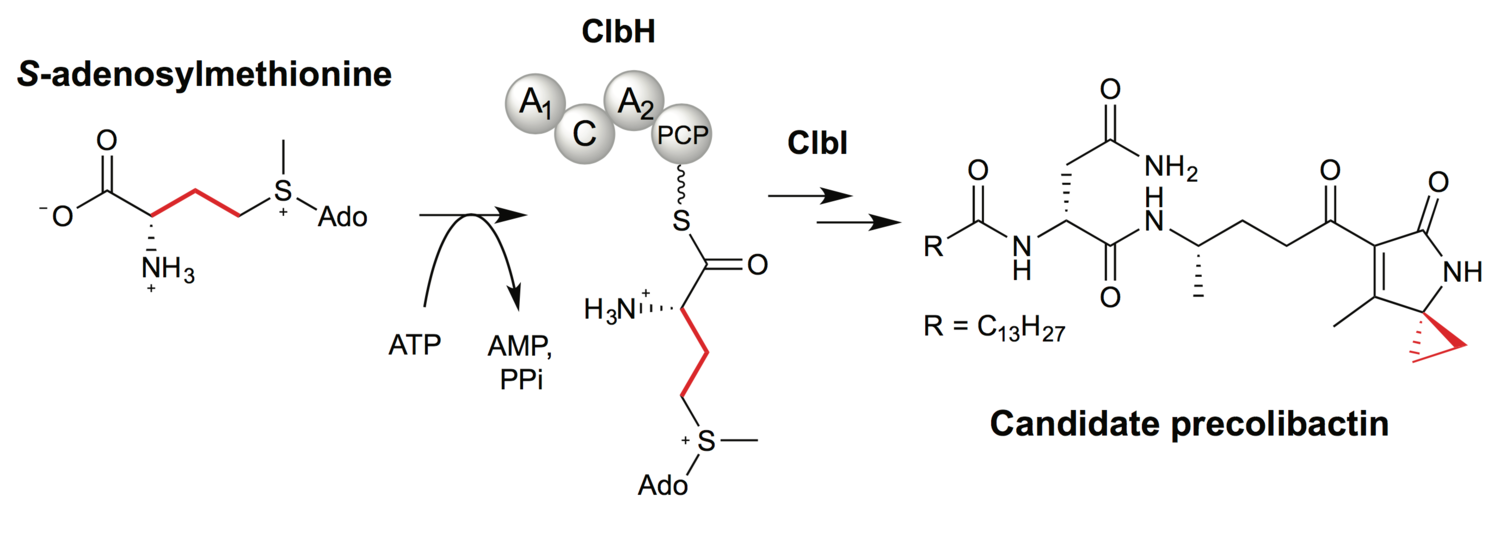October 5, 2017
CBC Senior Investigator, Neil Kelleher, NU, deciphers molecular assembly of a gut toxin, colibactin
Professor Neil Kelleher, PhD, joined Northwestern University in May 2010 as faculty of both the Weinberg College of Arts and Sciences (WCAS) and the Feinberg School of Medicine (FSM). CBC supported his recruitment as a CBC Senior Investigator through its Recruitment Resources Fund. Professor Kelleher is also Director of Northwestern Proteomics. His recent work on the structure of a toxin called colibactin is featured below.
Toxic Genetic Material’s Origins Discovered
Colibactin, a genotoxin produced by gut bacteria, including certain strains of E. Coli, which can damage DNA and is thought to contribute to colon cancer, is assembled with an enzyme cofactor, a chemical transformation never been seen before, according to Northwestern Medicine research published in Nature Chemical Biology.

Colibactin assembly line enzymes use S-adenosylmethionine to build a cyclopropane ring. Image credit: Balskus Lab
Prior to these findings, many of the mechanisms behind the molecular assembly of colibactin were largely unknown.
“Normally, cofactors help enzymes achieve catalysis, they don’t usually get involved in this manner,” said study co-author Neil Kelleher, PhD, professor of Molecular Biosciences in the Weinberg College of Arts and Sciences and of Medicine in the Division of Hematology and Oncology.
This cofactor, called S-adenosylmethionine (SAM), usually donates a methyl group to the substrate of an enzyme. In this case, a key enzyme involved in the production of colibactin takes that methyl group up in a very curious manner to build this toxin.

Neil Kelleher, PhD, professor of Molecular Biosciences in the Weinberg College of Arts and Sciences and of Medicine in the Division of Hematology and Oncology, was co-author on a study published in Nature Chemical Biology.
“This is a startlingly new enzymatic transformation in Nature,” Kelleher said. “It’s how evolution created this genotoxin, and we’re just now figuring out the real details for how this funny little three-membered ring in colibactin is created.”
Learning more about how colibactin forms is key to developing possible interventions, said Kelleher.
“The more you know about the underlying mechanisms, the more specific your strategy can be,” he said.
Screening Fungal Genomes for Drug Discovery
Kelleher’s genomic investigations have also resulted in the development of a novel platform for analyzing the genomes of fungi, which has the potential to yield scores of new bioactive molecules that could someday be developed into new drugs.
Previously published in Nature Chemical Biology and featured on the cover of the August issue, the multi-site study of the platform, called fungal artificial chromosomes and metabolic scoring (FAC-MS), showed that the approach is scalable and therefore has the potential to reinvigorate natural drug discovery.
FAC-MS breaks down the genome of fungi into ‘sub-megabase’ chunks of the genome coding for production of new metabolites. These metabolites represent an enormous untapped reservoir of potential drugs, according to the study. Because FAC-MS starts with DNA, scientists not only get the metabolites but the genes that created them, providing the ability to scale or alter the new compounds.
“It’s a hibernating area that’s ready to explode,” said Kelleher, also the director of Northwestern Proteomics and a professor of Biochemistry and Molecular Genetics.
The colibactin study acknowledges support from National Cancer Institute (1R01CA208834-01), the Damon Runyon–Rachleff Innovation Award, and the Packard Fellowship for Science and Engineering. The study was also supported by Northwestern University and the US National Institutes of Health (GM 067725 and AT 009143). It was also supported by an American Cancer Society-New England Division Postdoctoral Fellowship (PF-16-122-01-CDD).
The FAC-MS study was supported in part by the US National Institutes of Health (National Institute of Allergy and Infectious Diseases SBIR award in the form of grant R44AI094885; grant R01AT009143; grant R01-AI065728 to; grant 5T32GM105538-04; NMR instrumentation and assistance was provided by the Integrated Molecular Structure Education and Research Center (IMSERC) at Northwestern University.
Source:
Adapted (with modifications) from Northwestern University Feinberg School of Medicine News, by Will Doss, posted on September 28, 2017.
Publications attributed to the *CBC funding:
Zha L, Jiang Y, Henke MT, Wilson MR, Wang JX, Kelleher NL, Balskus EP. Colibactin assembly line enzymes use S-adenosylmethionine to build a cyclopropane ring. Nat Chem Biol. 2017 Oct;13(10):1063-1065. (PubMed)
Clevenger KD, Bok JW, Ye R, Miley GP, Verdan MH, Velk T, Chen C, Yang K, Robey MT, Gao P, Lamprecht M, Thomas PM, Islam MN, Palmer JM, Wu CC, Keller NP, Kelleher NL. A scalable platform to identify fungal secondary metabolites and their gene clusters. Nat Chem Biol. 2017 Aug;13(8):895-901. (PubMed)
See also:
*CBC Senior Investigator Award (2010):
▸ CBC Welcomes Newest “CBC Investigator” Neil Kelleher to NU
▸ Technology Unlocks Mold Genomes for New Drugs
Northwestern University Feinberg School of Medicine News, by Megan Fellman, posted on June 28, 2017.
